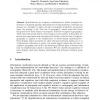Free Online Productivity Tools
i2Speak
i2Symbol
i2OCR
iTex2Img
iWeb2Print
iWeb2Shot
i2Type
iPdf2Split
iPdf2Merge
i2Bopomofo
i2Arabic
i2Style
i2Image
i2PDF
iLatex2Rtf
Sci2ools
COSIT
2003
Springer
2003
Springer
Testing the First Law of Cognitive Geography on Point-Display Spatializations
Abstract. Spatializations are computer visualizations in which nonspatial information is depicted spatially. Spatializations of large databases commonly use distance as a metaphor to depict semantic (nonspatial) similarities among data items. By analogy to the “first law of geography”, which states that closer things tend to be more similar, we propose a “first law of cognitive geography,” which states that people believe closer things are more similar. In this paper, we present two experiments that investigate the validity of the first law of cognitive geography as applied to the interpretation of “point-display spatializations.” Point displays depict documents (or other information-bearing entities) as 2- or 3-dimensional collections of points. Our results largely support the first law of cognitive geography and enrich it by identifying different types of distance that may be metaphorically related to similarity. We also identify characteristics of point displays other th...
| Added | 06 Jul 2010 |
| Updated | 06 Jul 2010 |
| Type | Conference |
| Year | 2003 |
| Where | COSIT |
| Authors | Daniel R. Montello, Sara Irina Fabrikant, Marco Ruocco, Richard S. Middleton |
Comments (0)

